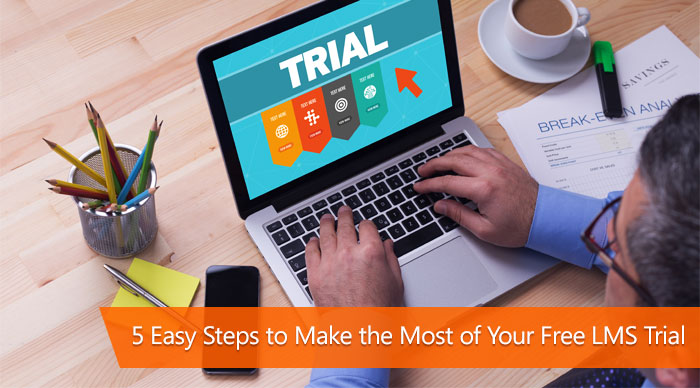A free LMS trial may seem like an ordinary opportunity to test a software, eventually finalizing it as an option worth investing in. However, it is not that simple. A free LMS trial is possibly the best chance for you to decide if the software you are looking at can solve your training needs. And many times, it is the last option you have before committing a mistake with long-term consequences.
Through our personal experience, we understood very early on that 15 or even 20 days of testing is not enough to completely understand an LMS and its functions. As a result of which, our trials evolved way beyond the usual 15–20 days’ mark, making it to an entire month! And over the years, many have initiated our free 30-Days LMS trials.
While most vendors allow you very little time to test a system before purchasing it, at Abara, we believe in precisely the opposite. If we had to let you test our LMS, the trial had to be nothing short of thirty days. The reason is simple—our LMS has a great UI and an even better UX. It also has an award-winning multi-tenant feature and the best overall employee training options available.
So, if we wanted you to test it, it had to be for a period of 30-Days.
But as people initiated more of our 30-Day trials, we realised that most were not testing the system to the fullest.
This unearthed a disturbing fact—people were initiating our trials, playing around unsuccessfully, and eventually abandoning the test halfway through!
Hence we decided, it is time to outline a set of guidelines. Guidelines that will help you test the system to its fullest!
On this Page
Here are 5 easy steps to make the most of your free LMS trial:
Step 1- Initiate an LMS Demo Call
More often than not, people assume that all LMS platforms function the same way. On initiating a thirty-day free trial, they understand how wrong that assumption can be. No matter how simple an LMS platform is, there are some inherent differences between them all. For a tester to understand the workings of a platform, a complementary LMS demo guided by a representative is important.
This is the best way to quickly understanding how the LMS works before proceeding to test and play with the platform for yourself.
When people skip the all-important step of setting up a free demonstration call, they end up wasting the free trial period. Some even declare the LMS as overly complicated. However, had they sat for a demo call, operating the LMS would have been much simpler. Furthermore, since they do not know how the platform works, they overcomplicate simple actions themselves. And in many cases, they try and operate the new LMS like a system they are already used to, and that just doesn’t work.
Setting-up a demo call is the best thing to do post initiating a free trial; users can actually test the LMS better if they know how to operate its basic functions.
Step 2- Add Courses and Learners to the System
After understanding the platform and its functions, the next step is to finally test the system. Most people limit the testing to clicking a few buttons, checking if the platform responds. They then enter and exit a few windows or change the colour schemes. However, that is an incomplete test.
By simulating actual administrative functions where the tester: adds courses, learners, sends out reminders, and check the analytics function—a real-time understanding of how the LMS will function under normal circumstances is achieved.
The tester must then log-in as a learner, test the newly added courses, and complete the module to see if the reports that are generated is what the organization wants. This is the right way of testing a system thoroughly. It gives the tester an exact idea of how easy the administration function is, how well the learner’s side performs, and how good the reporting features are.
Step 3- Test the Platform on All Devices
Now that the LMS trial has been initiated, and the platform works well on your desktop, you may think the system is all fine and end the test. This is a big misunderstanding. It is important for the LMS to function on all devices. Therefore, it is vital to test the system on mobile devices, laptops, and tablets as well.
Furthermore, testing the mobile app is a complete task in itself. There are multiple job roles like sales, distribution, and other field job roles that will eventually rely on the mobile app for instant access, hence the test must be comprehensive.
Something to remember here is—free LMS trials should always include multiple device tests. Since content can be consumed on any device—testing for device compatibility is very important.
Step 4- Map Your Needs
The LMS is being tested to check that all your training needs are met. Getting impressed with the bells and whistles is not the right way to select a system. It is important to list only the features you most certainly need to train your employees and check if the LMS is giving you those features.
At the same time, testing other visible features to understand if they add value to your training, helps in identifying an LMS suited to your needs.
As a good measure to follow, always select an LMS with the least amount of unrequired features.
Not only does this make your LMS easy to operate and understand, but it also makes it light and easy to operate on any device. This is very important for people who use the LMS when on the move.
Step 5- Re-schedule a Vendor Call
Surprisingly, the most critical part of your free LMS trial is the follow-up phone call with the vendor, post the free trial. The reason is simple—any shortcomings, added customizations needed, or missing features that you need can be easily discussed with the vendor.
It helps determine if these features can be added, if it’s in the product pipeline, or to identify another solution. It is the final step in ensuring that you make the best decision. After all, what is the point of testing a system and not checking with the vendor to see if your requirements can be met?
Many times, vendors are willing to make additional customizations to the LMS if you like the platform and assure the licensing of their system for an extended period (2–3 years). For you and the vendor to discuss this, a secondary call is important.
Conclusion:
The ability to freely try any system is the best opportunity to discover and learn about the platform. Initiating one, and not wholly using it, is a missed opportunity. A free trial is your primary tool to understand the LMS, and often, the last chance to select a good system.
As mentioned before, we believe in 30-Day trials because you must test the system to its fullest. So go ahead, activate the trial, but do not forget to schedule a demo call as well, it will help you understand Abara better. Click herem to initiate a free trial or reach out to us at contact@abaralms.com to schedule a demo. You could also click herem and one of our representatives will get in touch with you shortly!


